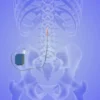Are you struggling with back pain or the feeling of your spine being tight with immobility? Stretching your back and increasing the flexibility of your posterior chain will improve the elasticity of your muscles, reducing the chance of injury and aches. Soon, you too can dramatically improve the pain and flexibility of your back muscles, but it must be done carefully to avoid injury.
One of the best ways to get started is to practice subtle backbends every day. Slowly, your flexibility will begin to improve, until eventually, your ambitions become a reality! So where can you start? Here are some ideas.
Cobra or Upward Facing Dog
Both Cobra and Upward-Facing Dog are relatively gentle backbends, making them a great place to begin.
If you’ve ever been to a yoga class, you’ve probably done Cobra. You start out by lying on your front and bringing your hands in line with your ribcage. Then you lift your torso up and come into a gentle backbend.
Start out with a subtle movement, keeping your elbows bent generously. When you’re comfortable, you can try straightening your arms and lifting your torso up all the way for a more significant backbend.
Once you’ve mastered Cobra, you may want to try Upward Facing Dog. This pose is similar to Cobra, except that your legs lift off the ground as well as your torso. It’s only the tops of your feet that remain on the mat.
Bridge Pose
To come into Bridge, lie on your back with your feet on the floor and your knees pointing up. Bring your hands to your sides with your palms facing down.
Then, slowly lift your hips while keeping your shoulders on the ground. Try to achieve a gentle backbend, but don’t force it. Hold the pose for a while, or come in and out of it by raising and lowering your hips as you inhale and exhale.
Crescent Lunge
For this pose, start out on all fours and then bring one foot forward, planting it on the ground with your knee directly above your ankle. Shift the opposite knee back slightly on the mat.
Then raise your arms above your head and gently bend backward so that you’re looking up slightly. If you like, you can lift your back knee for a slightly more challenging version of the pose.
Fish Pose
Start out by lying flat on your back, and place your palms face down underneath your buttocks. Point your toes.
Then, carefully tilt your neck so that the crown of your head is resting on the ground and your back is arched. Only hold the pose for as long as is comfortable, and be careful not to strain your neck.
Camel Pose
Camel pose is a little more advanced and requires care to make sure you don’t injure yourself.
Start out kneeling, with your hips directly above your knees – don’t sit back on your heels. Then bring your hands to the small of your back, with your fingers pointing upward.
Gently bend backward, using your hands to support you. If you experience any pain or discomfort, stop and come out of the pose.
Otherwise, you can try taking it further. The next stage is to reach your hands back and grab your heels, bending all the way back with the crown of your head pointing toward the floor. If this becomes uncomfortable, bring your hands back to the small of your back and return to a kneeling position.
Conclusion
If you practice these poses regularly, you’ll soon notice an improvement in your back pain, flexibility, and strength of your back muscles. Make sure to hold stretches long enough (20 – 30 seconds) to adequately lengthen your muscles and improve the range of motion. Pain that lasts longer than 3 months (chronic pain) may require weeks or months of regular stretching to successfully reduce pain. Over time, you could find that stretching could be the solution to your back pain and spinal flexibility. Good Luck!
If you are still struggling with chronic pain and are needing help, please check out the services we provide by clicking here!





